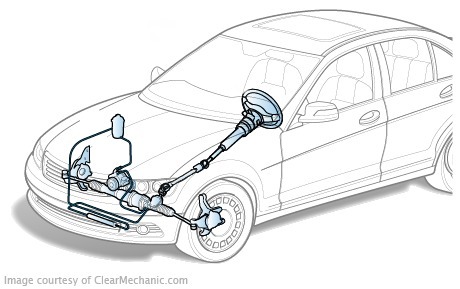
The steering wheel consists of two main components: the steering gear and the steering transmission. Some car models also provide a hydro-or electrical power steering system.
The steering wheel of the first vehicles had no steering wheel and driver's direction was changed by means of lever and stroke levers. The steering column was a semi-ring with two handgrip on it. In the future, the semicirring was simply closed, having received the prototype of the modern steering wheel, and the levers had been removed.
It is interesting that the steering trapeze appeared before the invention of the rudder and was applied on the very first cars with a steam engine for turning the wheels. This is the first car, which was invented in 1880 by French engineer A. Ball. By the way, his baby, Amad Ball, the older man, created in the province of Sarte, in the town Le Mans, which is known to the world today by its car racing track.
The construction of the steering trapeze markedly changed with the appearance of the independent wheel suspension. The transverse thrust had to be dismembened and fitted with additional ball joints. In the future, as a result of the car development, there is a gearer with a worm gear and a pendulum lever, which today is used in modern cars.
Modern construction of the steersman
The steering transmission, in the modern form, consists of the steering transmission in the form of a worm gear, the steering wheel, the left and right side steering, the medium thrust, the pendulum lever and the left and right turntable.
At the end of each of the steering gear there is a pivot that allows the movable parts of the steering transmission to be freely turned about the bodywork and each other in different planes.
The steering mechanism in the steering structure is necessary to increase the driver's steering and transmission of the steering transmission (the steersman).
The aim of the steering transmission is to drive the effort to the driving wheels by turning them into the left or right side, depending on the driver's action.
Scheme of work of the steering trapeze
When the steering wheel is turned on either side, the steering movement shall be transmitted through the steering shaft to the helmsman's worm gear, where the worm turns into motion by the shaft of the steering wheel. The chip is in turn connected to the middle and left side rod through the ball joints. At the same time, the middle thrust is connected to both the pendulum and the right side thrust. The left side and right side thrust forms are connected to the wheel-bending steering that turn to the right or left side, depending on the steering wheel command.
When steering the steering wheel drive, the steering wheel has to rotate the steering wheels on a certain angle. One condition must be met and the turn of the wheels must be different. This condition is simply necessary, or if the two wheels turn on the same size, the inner wheel will run on the road, thereby reducing the efficiency of the steering.
In addition, the wheel starts to warm, for example, the black mark of the wheel rubber on the brake, as it stops spinning and just slides along the road. This, in turn, would cause rapid deterioration of rubber and bearing of steps from over-heating.
This is handled by turning the inner wheel into a larger angle, with respect to the angle of turn of the outer wheel. At the turn of the turn, each wheel passes its trajectory, moving in different radiuses, and that is why the inner wheel needs a large rotation angle.
This ratio is fulfilled by means of the steering-trapeze structure, which includes turning levers and joints of steering traction. It is the selection of the angle of the tilt of the steering gear, their length and the length of the transverse drive, to achieve the necessary ratio of the angle of the wheels.
The steering gear shall consist of two steering gear, short and long, connected together by a coupler. The long tip has a left carving, which gives you the possibility to adjust the parameter as necessary to adjust the wheel ascent.
The ascent shall be displayed in all cases of intervention in the helmsman's trapezoid, or after the installation of the new trapeze during repairs. Check this option if the machine is hit, which is either an obstacle to the front suspension elements. The exception is the replacement of a torn bed when only the steering of the thumb is produced, which does not affect the amount of wheel convergence.
Malfunctioning helmsman
Strangers and steering wheel movement may be the result of loosing the driver's gear, a pendulum steering wheel or steering gear, the wear limit of the joints of the steering wheel, the relaxation of the latch of the pendulum lever or their wear, and the coupling of the worm-roller pair.
To resolve the detected problems, you must either adjust the connection in the gearbox or replace the worn parts. Usually, when there are more than two connections in the steering gear, the helmsman is replaced with all the traction of the trapeze to raise their overall resource.
When the rudder is heavy, it is possible, in addition to malfunctions of the gear reducer or the reduction of tyre pressure, to the angle of installation of the front wheels.
The most frequent failure of the Jointed Jointed Connections in the Tracks is related to the integrity of the protection of the helmsman's helmsman. The protection of the integrity of the protective blankets shall therefore be given high priority in the determination of the integrity of the cover. It is also necessary to check all hinged connections on trapeze, mechanical damage or drive deformation.







